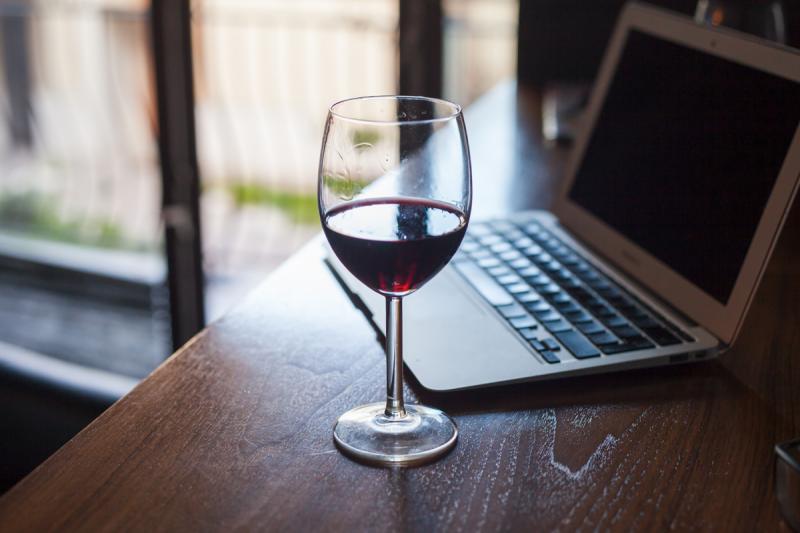Just got a new computer and screen. I'm thankful Maggie was at home to set them up for me, thereby freeing my hands to sip wine and write notes. I think I'll start off the week with a $10 Cab. Santa Ema Reserve Cabernet Sauvignon Maipo Valley Chile 2015 was chosen No. 29 of the WS top 100 and second-highest Cab on the top 100 with Meyer Napa Valley alone beating it out. Meyer sells for around $70. Santa Ema goes for $12, and it was also awarded Value Winery of the Year by Wine and Spirits. Lovely dark claret, opens to plums and berries, a touch of mint and savory herbs; medium tannins and proper acidity support all. It finishes long and clean with chocolate echoes. Santa Ema garnered 91 McD points. Wonderful table Cab will age at least five years. The upscale Santa Ema Amplus from Cachapoal Valley comes in at a whopping $20 and is definitely worth the money. I strongly recommend the 2012 of both if you can locate some; McD 91 and 92 respectively.
Another Chilean lovely is the Casa La Postolle Canto de Apalta from Rapel Valley, a red blend made of 30 percent Syrah, 25 Carmenere, 23 Merlot and 22 Cab Sauv. Fermented in stainless using wild yeast, four weeks maceration to provide lots of dark color and tart tannin, it then spent 12 months in used oaken barrels to provide softening without that sawdust flavor so many young reds exhibit. You will find licorice, black currant, and road tar aromas with firm tannin and a long, clean finish, 92 McD under $21.
Three readers wrote asking about Port: What is the difference between ruby and tawny? What is Colheita? Ruby ports are bottle-aged; tawny ports are barrel-aged, and Colheitas are vintage-dated tawny ports aged in small casks. The minimum age requirement for a Colheita is 7 years.
The best producers age several more years before bottling. 1997 Niepoort Colheita is a blend of Touriga Nacional, Touriga Franca, Tinta Cao, Francisca, Amarela, Souzao and Roriz. All are hand harvested, then "foot trodden in lagars" (people crushed them barefoot in cement tanks). Then the juice is drawn and fermented in small wooden casks. Neipoort bottled the 1997 in 2016, so that means they were aging in casks for at least 16 years, and they are yummy. Look for caramel, cedar, dried fruit, and honey. Still some tannin, so you can drink them or cellar, 96 points under $75. This is Niepoort's best effort of the past three decades.
Chardonnay is one of the most widely planted white varietal grapes. I recently read in an informative article by Sam Behrend that as of May 25, 2017, there were 1 million searches for Chardonnay on a famous site.
To put that in perspective, this was several hundred thousand more than for Riesling, the second-most sought. Double those for SB and four times those of Pinot Grigio and Pinot Gris combined. The research did exclude wine without "Chardonnay" in its name; therefore no Champagne and few White Burgundies were counted.
Although these are a very large part of Chardonnay, the poll-cats felt they couldn't be assured those searching knew they were made of Chard. Obviously those pollsters have never called youse guys. This screed allowed the top 10 searched names to be Cali Chards. Most of them were Napas. Kongsgaard The Judge at 95 points for $385 and their generic Napa Valley 93 points at $123 led the charge. As an aside, the No. 1 Cali white was Screaming Thieves Sauvignon Blanc at $4,937/bottle. Their Cab only sold for $3,337/bottle. Sonoma added Marcassin Estate Chard 95, $395; Kistler Vineyards 93, $123; Aubert Wines Lauren Vineyard 94, $193; and Peter Michael La Carriere Knights Valley 94, $123.
Two far better value buys are Stonestreet Alexander Mountain 2012 and Wayfarer Fort Ross-Seaview 2014, both rated 94 McD and cost mid $70s. Some others in the top 10 were: Cakebread, Far Niente Estate, Chateau Montelena and Rombauer. The article did mention that had Le Francais been allowed, they would have swept. The No. 1 searched was Domaine de la Romanee-Conti Montrachet Grand Cru at $5,356, which is more expensive than the total price of the top 10 Calis times three.
















































